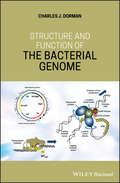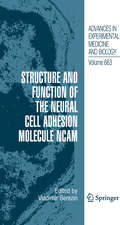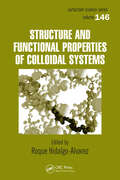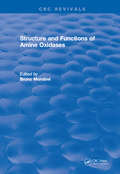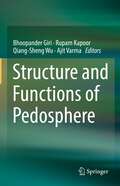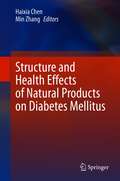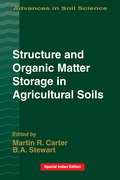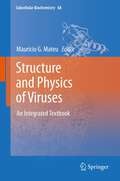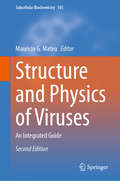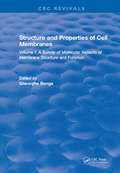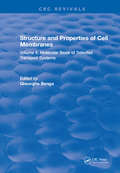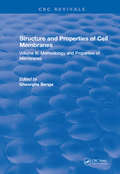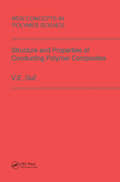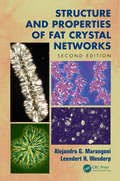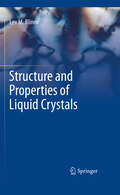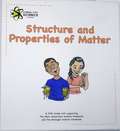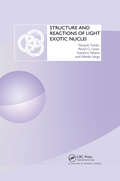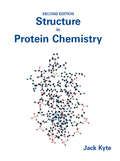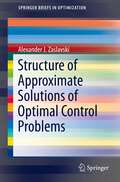- Table View
- List View
Structure and Function of the Bacterial Genome
by Charles J. DormanPresents an integrated view of the expression of bacterial genetic information, genome architecture and function, and bacterial physiology and pathogenesis This book blends information from the very latest research on bacterial chromosome and nucleoid architecture, whole-genome analysis, cell signaling, and gene expression control with well-known gene regulation paradigms from model organisms (including pathogens) to give readers a picture of how information flows from the environment to the gene, modulating its expression and influencing the competitive fitness of the microbe. Structure and Function of the Bacterial Genome explores the governance of the expression of the genes that make a bacterium what it is, and updates the basics of gene expression control with information about transcription promoter structure and function, the role of DNA as a regulatory factor (in addition to its role as a carrier of genetic information), small RNAs, RNAs that sense chemical signals, ribosomes and translation, posttranslational modification of proteins, and protein secretion. It looks at the forces driving the conservation and the evolution of the dynamic genome and offers chapters that cover DNA replication, DNA repair, plasmid biology, recombination, transposition, the roles of repetitive DNA sequences, horizontal gene transfer, the defense of the genome by CRISPR-Cas, restriction enzymes, Argonaute proteins and BREX systems. The book finishes with a chapter that gives an integrated overview of genome structure and function. Blends knowledge of gene regulatory mechanisms with a consideration of nucleoid structure and dynamics Offers a 'DNA-centric' approach to considering transcription control Views horizontal gene transfer from a gene regulation perspective Assesses the opportunities and limitations of designing synthetic microbes or rewiring existing ones Structure and Function of the Bacterial Genome is an ideal book for graduate and undergraduate students studying microbial cell biology, bacterial pathogenesis, gene regulation, and molecular microbiology. It will also appeal to principal investigators conducting research on these and related topics and researchers in synthetic biology and other arms of biotechnology.
Structure and Function of the Body (10th Edition)
by Gary A. Thibodeau Kevin T. PattonThis edition of Structure & Function of the Body retains many features that have proved successful in over 35 years of classroom use; yet as a new text it presents a wealth of carefully selected new content, as well as pedagogical enhancements that will better serve the needs of today's instructors and students.
Structure and Function of the Neural Cell Adhesion Molecule NCAM
by Vladimir BerezinThis book contains review articles that produce a snapshot of recent developments in the field of the neural cell adhesion molecule NCAM. The chapters are grouped into sections reflecting various aspects of NCAM structure and function. The themes cover the structural basis of cell adhesion mediated by NCAM and NCAM interaction partners, NCAM-mediated signaling determinants of NCAM function under physiological conditions and in disease, and the therapeutic potential of NCAM mimetics.
Structure and Functional Properties of Colloidal Systems (Surfactant Science)
by Roque Hidalgo-ÁlvarezIntegrating fundamental research with the technical applications of this rapidly evolving field, Structure and Functional Properties of Colloidal Systems clearly presents the connections between structure and functional aspects in colloid and interface science. It explores the physical fundamentals of colloid science, new developments of synthesis
Structure and Functions of Amine Oxidases
by MondoviA good portion of this book has been devoted to the copper-dependent enzymes, these being the more numerous. The chapter dealing with serum amine oxidases also focuses attention on their catalytic mechanism, as these enzymes have been studied in greater depth.As the presentation of topics whose experimental basis is rapidly developing is likely to stimulate the reader‘s interest, many bibliographic references have been included.Readers could find this book poor, as far as many topics are dealt with in a relatively little space, but we believe it essential to trace the background of our present knowledge in the field of amine oxidases, stressing the future outlook of research on these enzymes, for they are becoming more and more important in general and medical biochemistry.
Structure and Functions of Pedosphere
by Ajit Varma Qiang-Sheng Wu Bhoopander Giri Rupam KapoorThis edited volume covers all aspects of the latest research in the field of soil formation and its functioning, soil diversity, soil proteomics, the impact of anthropogenic activities on the pedosphere, plant-microbe interactions in the pedosphere, and factors influencing the formation and functioning of the soils. In the pedosphere, all forms of soils possess a particular type of structure and different organic and mineral components. Thus, the pedosphere as a whole plays a significant role in providing unique habitats for a vast diversity of life forms, developing a link between geological and biological substances circulation in the terrestrial ecosystems. In the processes making available vital mineral elements to plants and supporting human health as various trace elements in the lithosphere are accessed by people through the formation of soils and such soils are utilized for food production. With the depth of information on different aspects of soil, this extensive volume is a valuable resource for the researchers in the area of soil science, agronomy, agriculture, scientists in academia, crop consultants, policymakers, government from diverse disciplines, and graduate and post-graduate students in the area of soil and environmental science.
Structure and Health Effects of Natural Products on Diabetes Mellitus
by Min Zhang Haixia ChenThe purpose of this book is to introduce the classified chemical components of hypoglycemic compounds in natural products, summarize the recent research progress of natural products with hypoglycemic activity in the past 20 years, and provide the original analysis and development opinions of relevant scholars. Hypoglycemic compounds are to target diabetes mellitus, an important public health problem, one of four priority noncommunicable diseases (NCDs) targeted for action by world leaders. Diabetes mellitus is a common endocrine and metabolic disease, which not only causes physiological damage to patients' kidneys, cardiovascular and cerebrovascular vessels, peripheral blood vessels, nerves and eyes, but also causes mental and psychological pressure to patients. Due to the evidence that traditional medicine and natural herbal formula have advantages in treating diabetes, natural products with hypoglycemic activity have been studied extensively in recent years and have been accepted by many scholars all over the world.This book focuses on the progress on the study of the structure, hypoglycemic activities, structure-activity relationships and mechanism of a wide range of polysaccharides, flavonoids, saponins, alkaloids, terpenoids, polyphenols and other constituents. It will help students and researchers to understand current approaches and progress in the treatment of diabetes with natural products, which may also be beneficial to develop new hypoglycemic drugs.
Structure and Method in Aristotle's Meteorologica
by Malcolm WilsonIn the first full-length study in any modern language dedicated to the Meteorologica, Malcolm Wilson presents a groundbreaking interpretation of Aristotle's natural philosophy. Divided into two parts, the book first addresses general philosophical and scientific issues by placing the treatise in a diachronic frame comprising Aristotle's predecessors and in a synchronic frame comprising his other physical works. It argues that Aristotle thought of meteorological phenomena as intermediary or 'dualizing' between the cosmos as a whole and the manifold world of terrestrial animals. Engaging with the best current literature on Aristotle's theories of science and metaphysics, Wilson focuses on issues of aetiology, teleology and the structure and unity of science. The second half of the book illustrates Aristotle's principal concerns in a section-by-section treatment of the meteorological phenomena and provides solutions to many of the problems that have been raised since the time of the ancient commentators.
Structure and Organic Matter Storage in Agricultural Soils
by B.A. Stewart M.R. CarterSoils comprise the largest pool of terrestrial carbon and therefore are an important component of carbon storage in the biosphere-atmosphere system. Structure and Organic Matter Storage in Agricultural Soils explores the mechanisms and processes involved in the storage and sequestration of carbon in soils. Focusing on agricultural soils - from tropical to semi-arid types - this new book provides an in-depth look at structure, aggregation, and organic matter retention in world soils. The first two sections of the book introduce readers to the basic issues and scientific concepts, including soil structure, underlying mechanisms and processes, and the importance of agroecosystems as carbon regulators. The third section provides detailed discussions of soil aggregation and organic matter storage under various climates, soil types, and soil management practices. The fourth section addresses current strategies for enhancing organic matter storage in soil, modelling techniques, and measurement methods.Throughout the book, the importance of the soil structure-organic matter storage relationship is emphasized. Anyone involved in soil science, agriculture, agronomy, plant science, or greenhouse gas and global change studies should understand this relationship. Structure and Organic Matter Storage in Agricultural Soils provides an ideal source of information not only on the soil structure-storage relationship itself, but also on key research efforts and direct applications related to the storage of organic matter in agricultural soils.
Structure and Physics of Viruses
by Mauricio G. MateuThis book contemplates the structure, dynamics and physics of virus particles: From the moment they come into existence by self-assembly from viral components produced in the infected cell, through their extracellular stage, until they recognise and infect a new host cell and cease to exist by losing their physical integrity to start a new infectious cycle. (Bio)physical techniques used to study the structure of virus particles and components, and some applications of structure-based studies of viruses are also contemplated. This book is aimed first at M.Sc. students, Ph.D. students and postdoctoral researchers with a university degree in biology, chemistry, physics or related scientific disciplines who share an interest or are actually working on viruses. We have aimed also at providing an updated account of many important concepts, techniques, studies and applications in structural and physical virology for established scientists working on viruses, irrespective of their physical, chemical or biological background and their field of expertise. We have not attempted to provide a collection of for-experts-only reviews focused mainly on the latest research in specific topics; we have not generally assumed that the reader knows all of the jargon and all but the most recent and advanced results in each topic dealt with in this book. In short, we have attempted to write a book basic enough to be useful to M.Sc and Ph.D. students, as well as advanced and current enough to be useful to senior scientists with an interest in Structural and/or Physical Virology.
Structure and Physics of Viruses: An Integrated Guide (Subcellular Biochemistry #105)
by Mauricio G. MateuThe second edition of this book provides a completely updated account of the structure, dynamics, and physics of viral particles: from the moment they emerge by self-assembly from viral components produced in the infected cell, through their extracellular stage, until they recognize and infect a new host cell and cease to exist as they lose their physical integrity to initiate a new infectious cycle. New insights into the structure of viruses, their physical properties, and mechanisms of action, derived from results obtained in the last decade, have been included, as well as other (bio)physical techniques to study the structure or dynamics of virus particles and components. These include, among many others, new advances in high-resolution electron cryomicroscopy; novel approaches in the use of electron cryotomography or the application of soft X-ray tomography to study viruses in the infected cell; high-speed atomic force microscopy to study virus assembly and dynamics; and the development of new antiviral drugs and vaccines. as well as of many nanomedical and nanotechnological applications of virus particles. New chapters on the study of viruses inside infected cells and on technological applications of modified viral particles have been included in this second edition. The book is still aimed primarily at Master's students, Ph.D. students, and postdoctoral researchers with degrees in biology, chemistry, physics or related scientific disciplines who have an interest in or are working with viruses. It provides an up-to-date overview of many important concepts, techniques, studies and applications in structural and physical virology for specialized researchers working with viruses, regardless of their field of specialization, covering the latest research together with fundamental concepts and well-established facts. In short, this book is basic enough to be used by undergraduate and Ph.D. students, but advanced and up-to-date enough for experienced scientists with an interest in structural and/or physical virology.
Structure and Properties of Cell Membrane Structure and Properties of Cell Membranes: Volume I (Structure And Properties Of Cell Membranes Ser.)
by BengaThis book provides in-depth presentations in membrane biology by specialists of international repute. The volumes examine world literature on recent advances in understanding the molecular struc-ture and properties of membranes, the role they play in cellular physiology and cell-cell interactions, and the alterations leading to abnormal cells. Illustrations, tables, and useful appendices com-plement the text. Those professionals actively working in the field of cell membrane investigations as well as biologists, biochemists, biophysicists, physicians, and academicians, will find this work beneficial.
Structure and Properties of Cell Membrane Structure and Properties of Cell Membranes: Volume II (Structure And Properties Of Cell Membranes Ser.)
by BengaThis book provides in-depth presentations in membrane biology by specialists of international repute. The volumes examine world literature on recent advances in understanding the molecular struc-ture and properties of membranes, the role they play in cellular physiology and cell-cell interactions, and the alterations leading to abnormal cells. Illustrations, tables, and useful appendices com-plement the text. Those professionals actively working in the field of cell membrane investigations as well as biologists, biochemists, biophysicists, physicians, and academicians, will find this work beneficial.
Structure and Properties of Cell Membrane Structure and Properties of Cell Membranes: Volume III (Structure And Properties Of Cell Membranes Ser.)
by BengaThis book provides in-depth presentations in membrane biology by specialists of international repute. The volumes examine world literature on recent advances in understanding the molecular struc-ture and properties of membranes, the role they play in cellular physiology and cell-cell interactions, and the alterations leading to abnormal cells. Illustrations, tables, and useful appendices com-plement the text. Those professionals actively working in the field of cell membrane investigations as well as biologists, biochemists, biophysicists, physicians, and academicians, will find this work beneficial.
Structure and Properties of Conducting Polymer Composites
by V.E. GulThe development of the principles of electrically conductive polymer composites and the creation of a wide variety of such materials have had a significant influence on modern technology. This volume in the "New Concepts in Polymer Science" series is devoted to various aspects of the structure and properties of electrically conductive polymer composites. This monograph is an attempt to systematize modern ideas on the interconnection of the structure and properties of ECPCs. Specific attention is given to the influence of electric current on kinetics and the direction of chemical interactive processes between such systems and air oxygen. The book also contains a special chapter which is devoted to the practical applications of electrically conductive polymer composites. It should be of use and interest to researchers working in the field.
Structure and Properties of Fat Crystal Networks
by Alejandro G. Marangoni Leendert H. WesdorpLipid science and technology has grown exponentially since the turn of the millennium. The replacement of unhealthy fats in the foods we eat, and of petroleum-based ingredients in the cosmetics we use, is a top priority for consumers, government, and industry alike. Particularly for the food industry, removing trans fats and reducing saturated fat
Structure and Properties of Liquid Crystals
by Lev M. BlinovThis book introduces the most important concepts related to the structure and physical properties of liquid crystals, including some of the theoretical aspects. It consists of three parts: structure, physical properties, and electro-optic behavior.
Structure and Properties of Matter
by Janette SchusterMatter, States of Matter, Physical Properties of Matter, Mixtures, Physical and Chemical Changes, Conserving Matter, Science and Engineering Practices, Careers.
Structure and Properties of Matter Journal
by Battle CenterStudents explore matter in terms of measurable properties and as made up of particles too small to be seen. Students develop an understanding that the number of particles and weight of matter does not change regardless of the changes it goes through.
Structure and Reactions of Light Exotic Nuclei
by Yasuyuki Suzuki Kazuhiro Yabana Rezso G. Lovas Kalman VargaSince the mid-1980s increasing effort has been put into light exotic nuclei, that is light nuclei of unusual composition. The research of the exotic nuclei began with the advent of accelerated beams of such nuclei. This new technique has revitalized nuclear physics, and the facilities producing radioactive ion beams now offer opportunities for pion
Structure in Protein Chemistry
by Jack KyteThe second edition of Structure in Protein Chemistry showcases the latest developments and innovations in the field of protein structure analysis and prediction. The book begins by explaining how proteins are purified and describes methods for elucidating their sequences of amino acids and defining their posttranslational modifications. Comprehensive explanations of crystallography and of noncovalent forces-ionic interactions, hydrogen bonding, and the hydrophobic effect-act as a prelude to an exhaustive description of the atomic details of the structures of proteins. The resulting understanding of protein molecular structure forms the basis for discussions of the evolution of proteins, the symmetry of the oligomeric associations that produce them, and the chemical, mathematical, and physical basis of the techniques used to study their structures. The latter include image reconstruction, nuclear magnetic resonance spectroscopy, proton exchange, optical spectroscopy, electrophoresis, covalent cross-linking, chemical modification, immunochemistry, hydrodynamics, and the scattering of light, X-radiation, and neutrons. These procedures are applied to study the folding of polypeptides and the assembly of oligomers. Biological membranes and their proteins are also discussed. Structure in Protein Chemistry, Second Edition, bridges the gap between introductory biophysical chemistry courses and research literature. It serves as a comprehensive textbook for advanced undergraduates and graduate students in biochemistry, biophysics, and structural and molecular biology. Professionals engaged in chemical, biochemical, and molecular biological research will find it a useful reference.
Structure of Approximate Solutions of Optimal Control Problems
by Alexander J. ZaslavskiThis title examines the structure of approximate solutions of optimal control problems considered on subintervals of a real line. Specifically at the properties of approximate solutions which are independent of the length of the interval. The results illustrated in this book look into the so-called turnpike property of optimal control problems. The author generalizes the results of the turnpike property by considering a class of optimal control problems which is identified with the corresponding complete metric space of objective functions. This establishes the turnpike property for any element in a set that is in a countable intersection which is open everywhere dense sets in the space of integrands; meaning that the turnpike property holds for most optimal control problems. Mathematicians working in optimal control and the calculus of variations and graduate students will find this book useful and valuable due to its presentation of solutions to a number of difficult problems in optimal control and presentation of new approaches, techniques and methods.
Structure of Materials: An Introduction to Crystallography, Diffraction and Symmetry
by Marc De Graef Michael E. MchenryThis highly readable, popular textbook for upper undergraduates and graduates comprehensively covers the fundamentals of crystallography and symmetry, applying these concepts to a large range of materials. New to this edition are more streamlined coverage of crystallography, additional coverage of magnetic point group symmetry and updated material on extraterrestrial minerals and rocks. New exercises at the end of chapters, plus over 500 additional exercises available online, allow students to check their understanding of key concepts and put into practice what they have learnt. Over 400 illustrations within the text help students visualise crystal structures and more abstract mathematical objects, supporting more difficult topics like point group symmetries. Historical and biographical sections add colour and interest by giving an insight into those who have contributed significantly to the field. Supplementary online material includes password-protected solutions, over 100 crystal structure data files, and Powerpoints of figures from the book.
